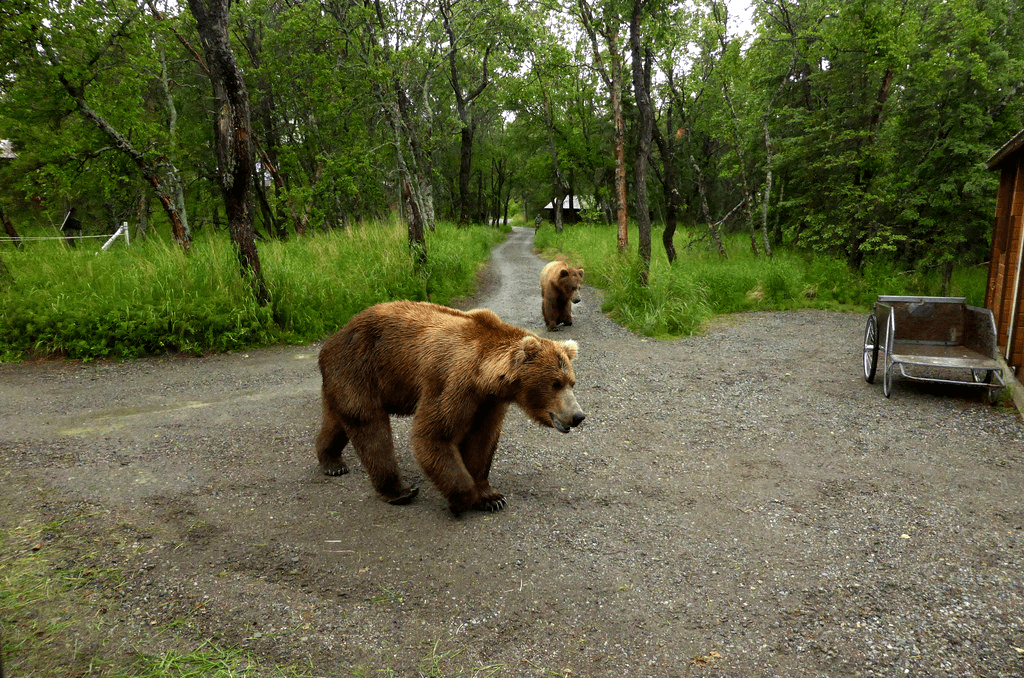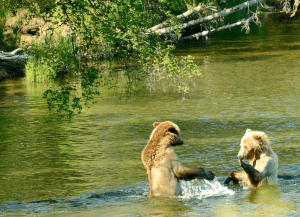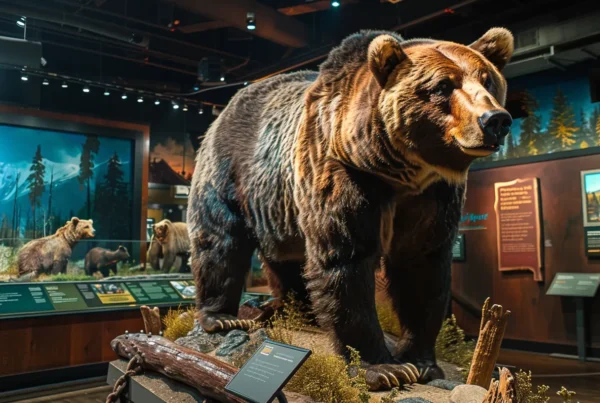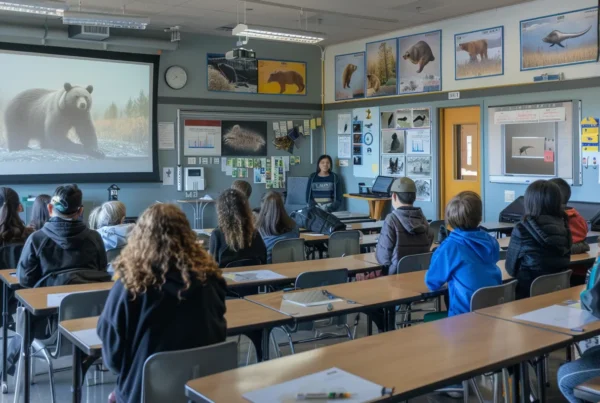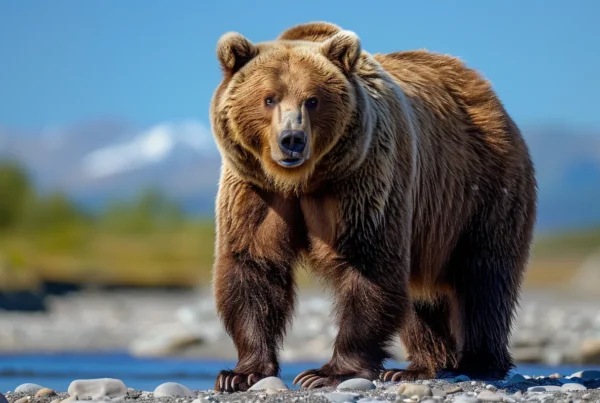Alaska Brown Bear Behavior
The Alaska Brown Bear are characteristically solitary animals. The majority of their interaction is at rivers and lakes where large populations of salmon hold and congregate. To maintain their personal space the Alaska brown bear uses different types of communication and behaviors. What is interesting is that their limited gamut of behaviors is not ritualized and their connotation is heavily reliant on the circumstance of the situation. It is important to concern yourself with different Alaska brown bear behaviors. At the same time, one must take into account the broad and common meaning in its specific context because each behavior is highly unique.
The following is from “The Bear Fact” published by the Alaska Natural History Association in cooperation with the National Park Service. Upon understanding some of the general meanings of their behaviors you will have a different perspective when on your bear viewing tours.
Alaks Brown Bear Posturing
Standing – An Alaska brown bear standing on his hind legs is typically not expressing aggression. Bears generally stand on their hind legs to gain more information visually and through smell.
Stationary Orientation – An Alaska brown bear may stand broadside to assert itself in some instances. In encounters with humans, it has usually been interpreted as a demonstration of size.
Stationary Facing You – If an Alaska brown bear is standing and facing you, it is certainly not being submissive. This is an aggressive position and may signal a charge. It is likely waiting for you to withdraw.
Vocalizations
Huffs – When a bear is tense, it may forcible exhale a series of several sharp, rasping huffs. A mother may also huff in order to gain the attention of her young.
Woofing – A startled bear may emit a single sharp exhale called a woof which lacks the harsh quality of a huff. If her cubs woof, a mother will become alert to the situation.
Popping Sounds – Females with young often emit a throaty popping sound, apparently to beckon their cubs when danger is sensed. A mother vocalizing in this manner should be considered nervous and extremely stressed. Bears other than sows also jaw-pop
Growling – A clear indication of intolerance and possible aggression is coming when growls, snarls, and roars are heard.
Yawn – Indicates tension. This behavior may result from the close proximity of another bear or human presence.
Another Indicator
Salivation – A clear sign of tension, excessive salivation may appear as white foam around the bear’s mouth. Only severely distressed bears exhibit this characteristic.
Charging – The vast majority of charges are false charges one in which the bear stops before making final contact. The intensity of the charge or associated vocalizations may vary, but it is distinct in that it is an aggressive or defensive act clearly directed at another bear or human. Bears may charge immediately, as a sow fearing for her cubs, or may emit stressed or erratic behavior before charging.
Sleeping Bears – It is very common for adult bears to sleep near a prominent food source, example a small river or stream full of spawning Salmon, a moose or Caribou carcass or gut pile, Never startle a sleeping Bear this is a very dangerous position and death can Occur.
Be Alert – By understanding bear behavior clues, you may have a better understanding of how they will react to different situations. But remember, when in bear country it is important to be alert, watch for bear signs (scat and markings on trees), avoid areas of limited visibility, make noise when walking around, and travel with others. The best way to be safe around these animals is to give them lots of space and to avoid surprise encounters.
Be Safe – The ability to grasp the meaning of their behaviors is not the answer to being safe in bear country. It is highly recommended not to go into bear country alone. Traveling with a group or better yet an experienced guide is the best bet.
Alaska Brown Bear facts
Alaska brown bears (Ursus arctos) occur throughout Alaska except on the islands south of Frederick Sound in southeastern Alaska, the islands west of Unimak in the Aleutian Chain, and the islands of the Bering Sea. They also occur in Canada, Asia, Europe, and in limited numbers in a few western states. Brown bears are very much a part of the Alaska scene and are a favorite topic with most hunters, hikers, photographers, and fishers.
General description: Formerly, taxonomists listed brown and grizzly bears as separate species. Technically, brown and grizzly bears are classified as the same species, Ursus arctos. Brown bears on Kodiak Island are classified as a distinct subspecies from those on the mainland because they are genetically and physically isolated. The shape of their skulls also differs slightly.
The term “brown bear” is commonly used to refer to the members of this species found in coastal areas where salmon is the primary food source. Brown bears found inland and in northern habitats are often called “grizzlies.” In this paper, brown bear is used to refer to all members of Ursus arctos.
The brown bear resembles its close relative the black bear, Ursus americanus. The brown bear, however, is usually larger, has a more prominent shoulder hump, less prominent ears, and longer, straighter claws. Both the prominent hump and the long claws of the brown bear are adaptations that are related to feeding behavior. The long claws are useful in digging for roots or excavating burrows of small mammals. The musculature and bone structure of the hump are adaptations for digging and for attaining bursts of speed necessary for capture of moose or caribou for food. Color is not a reliable key in differentiating these bears because both species have many color phases. Black bears, for example, occur in many hues of brown, and even shades of blue and white. Brown bear colors range from dark brown through light blond.
Bear weights vary depending on the time of year. Bears weigh the least in the spring or early summer. They gain weight rapidly during late summer and fall and are waddling fat just prior to denning. At this time most mature males weigh between 500 and 900 pounds (180-410 kg) with extremely large individuals weighing as much as 1,400 pounds (640 kg). Females weigh half to three-quarters as much. An extremely large brown bear may have a skull 18 inches long (46 cm) and 12 inches wide (30 cm). Such a bear, when standing on its hind feet, is about 9 feet (2.7 m) tall. Inland bears are usually smaller than coastal bears, probably because they do not have a readily available supply of protein-rich food, such as salmon, in their diet.
Alaska brown bears have been known to live 34 years in the wild, though this is rare. Usually, old males may reach 22 years. Old females may live to 26. Brown bears have an especially good sense of smell and under the right conditions may be able to detect odors more than a mile distant. Their hearing and eyesight are probably equivalent to that of humans. When bears stand upright, it is not to get ready to charge but to test the wind and to see better.
Life history: Mating takes place from May through July with the peak of activity in early June. Brown bears generally do not have strong mating ties. Individual bears are rarely seen with a mate for more than a week. Males may mate with more than one female during breeding season. The hairless young, weighing less than a pound, are born the following January or February in a winter den. Litter size ranges from one to four cubs, but two is most common. Offspring typically separate from their mothers as 2-year olds in May or June. Following separation, the mother can breed again and produce a new litter of cubs the following year. In some parts of Alaska, research results reveal that offspring may not separate from their mothers until they are 3 to 5 years old. This appears to be most common in areas where food is scarce. In some of these areas, females may skip one to three years before producing new litters.
Alaska brown bear populations vary depending on the productivity of the environment. In areas of low productivity, such as on Alaska’s North Slope, studies have revealed bear densities as low as one bear per 300 square miles. In areas teeming with easily available food, such as Admiralty Island in Southeast Alaska, densities as high as one bear per square mile have been found. In central Alaska, both north and south of the Alaska Range, bear densities tend to be intermediate, about one bear per 15-23 square miles. These are average figures which shouldn’t be interpreted to mean that each bear has this much territory for its exclusive use. The area occupied by any individual bear may overlap that used by many other individuals.
Safety: All Alaska brown bears should be treated with respect and can be safely observed only from a distance of at least 100 yards. This is especially true for family groups of a female and her offspring as mother bears are very protective towards their young. Alaska brown bears protecting a food source, such as the buried carcass of a moose or caribou, should also be treated with special caution. In bear country, campers can best avoid conflicts with bears if they minimize food odors, store their food out of a bear’s reach and away from their camp, and avoid camping on bear travel routes.
Food habits: Like humans, brown bears consume a wide variety of foods. Common foods include berries, grasses, sedges, horsetails, cow parsnips, fish, ground squirrels, and roots of many kinds of plants. In some parts of Alaska, brown bears have been shown to be capable predators of newborn moose and caribou. They can also kill and consume healthy adults of these species and domestic animals. Bears are fond of all types of carrion as well as garbage in human dumps.
Except for females with offspring and breeding animals, bears are typically solitary creatures and avoid the company of other bears. Exceptions to this occur where food sources are concentrated such as streams where bears can catch salmon swimming upstream to spawn. At McNeil River Falls, the largest concentration of brown bears occurs annually. Biologists have observed more than 60 bears at one time, attracted by spawning salmon.
Winter dormancy: In the winter when food is unavailable or scarce, most Alaska brown bears enter dens and hibernate through the winter. While in this state, their body temperatures, heart rate, and other metabolic rates are reduced. Their need for food and water is eliminated. In northern areas with long hard winters, bears may spend from 5 to 7 ½ months in dens. In areas with relatively warmer winters, such as Kodiak Island, a few bears may stay active all winter. Pregnant females are usually the first to enter dens in the fall. These females, with their newborn cubs, are the last to exit dens. Adult males, on the other hand, appear to enter dens later and emerge earlier than most other bears.
Research and conservation: Because Alaska contains over 98 percent of the United States population of brown bears, and more than 70 percent of the North American population, it has a special responsibility for this large carnivore. The Alaska Department of Fish and Game is responsible for managing bears in Alaska and for ensuring that management is based on scientific knowledge of the biology of bear populations. Important components of this management effort include maintaining healthy populations of bears throughout Alaska, conservation of bear habitat, prevention of overharvest, and conducting the studies necessary to understand population requirements. As Alaska continues to develop, it is increasingly important for the public to recognize that conserving sufficient amounts of habitat is necessary for brown bears to continue to thrive in Alaska.

